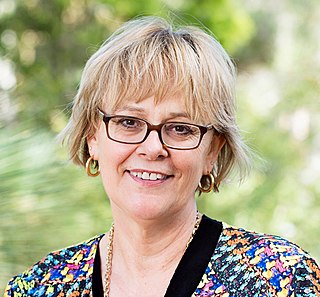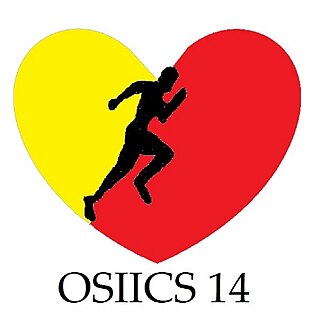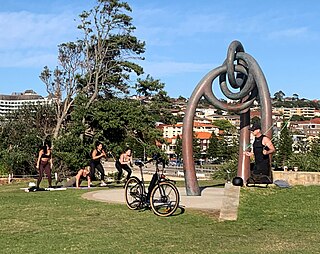
Fever or pyrexia in humans is a symptom of organism's anti-infection defense mechanism that appears with body temperature exceeding the normal range due to an increase in the body's temperature set point in the hypothalamus. There is no single agreed-upon upper limit for normal temperature: sources use values ranging between 37.2 and 38.3 °C in humans.
Internal medicine, also known as general internal medicine in Commonwealth nations, is a medical specialty for medical doctors focused on the prevention, diagnosis, and treatment of internal diseases in adults. Medical practitioners of internal medicine are referred to as internists, or physicians in Commonwealth nations. Internists possess specialized skills in managing patients with undifferentiated or multi-system disease processes. They provide care to both hospitalized (inpatient) and ambulatory (outpatient) patients and often contribute significantly to teaching and research. Internists are qualified physicians who have undergone postgraduate training in internal medicine, and should not be confused with "interns", a term commonly used for a medical doctor who has obtained a medical degree but does not yet have a license to practice medicine unsupervised.

Carbohydrate loading, commonly referred to as carb-loading, or carbo-loading, is a strategy used by endurance athletes, such as marathoners and triathletes, to reduce fatigue during an endurance event by maximizing the storage of glycogen in the muscles and liver. Carbohydrate consumption is increased in the days before an endurance event.

Sports science is a discipline that studies how the healthy human body works during exercise, and how sports and physical activity promote health and performance from cellular to whole body perspectives. The study of sports science traditionally incorporates areas of physiology, psychology, anatomy, biomechanics, biochemistry, and kinesiology.

Sports medicine is a branch of medicine that deals with physical fitness and the treatment and prevention of injuries related to sports and exercise. Although most sports teams have employed team physicians for many years, it is only since the late 20th century that sports medicine emerged as a distinct field of health care. In many countries, now over 50, sports medicine is a recognized medical specialty. In the majority of countries where sports medicine is recognized and practiced, it is a physician (non-surgical) specialty, but in some, it can equally be a surgical or non-surgical medical specialty, and also a specialty field within primary care. In other contexts, the field of sports medicine encompasses the scope of both medical specialists as well as allied health practitioners who work in the field of sport, such as physiotherapists, athletic trainers, podiatrists and exercise physiologists.
Performance-enhancing substances (PESs), also known as performance-enhancing drugs (PEDs), are substances that are used to improve any form of activity performance in humans.

Heat illness is a spectrum of disorders due to increased body temperature. It can be caused by either environmental conditions or by exertion. It includes minor conditions such as heat cramps, heat syncope, and heat exhaustion as well as the more severe condition known as heat stroke. It can affect any or all anatomical systems. Heat illnesses include: heat stroke, heat exhaustion, heat syncope, heat edema, heat cramps, heat rash, heat tetany.

Elastic therapeutic tape, also called kinesiology tape or kinesiology therapeutic tape, Kinesio tape, k-tape, or KT is an elastic cotton strip with an acrylic adhesive that is purported to ease pain and disability from athletic injuries and a variety of other physical disorders. In individuals with chronic musculoskeletal pain, research suggests that elastic taping may help relieve pain, but not more than other treatment approaches, and no evidence indicates that it can reduce disability in chronic pain cases.

The effects of climate change on human health are profound because they increase heat-related illnesses and deaths, respiratory diseases, and the spread of infectious diseases. There is widespread agreement among researchers, health professionals and organizations that climate change is the biggest global health threat of the 21st century.
A medical abortion, also known as medication abortion or non-surgical abortion, occurs when drugs (medication) are used to bring about an abortion. Medical abortions are an alternative to surgical abortions such as vacuum aspiration or dilation and curettage. Medical abortions are more common than surgical abortions in most places around the world.

Head injuries in sports of any level are the most dangerous kind of injuries that can occur in sport, and are becoming more common in Australian sport. Concussions are the most common side effect of a head injury and are defined as "temporary unconsciousness or confusion and other symptoms caused by a blow to the head." A concussion also falls under the category of Traumatic Brain Injury (TBI). Especially in contact sports like Australian rules football and rugby, issues with concussions are prevalent, and methods to deal with, prevent and treat concussions are continuously being updated and researched to deal with the issue. Concussions pose a serious threat to the patients’ mental and physical health, as well as their playing career, and can result in lasting brain damage especially if left untreated. The signs that a player may have a concussion are: loss of consciousness or non-responsiveness, balance problems, a dazed, blank or vacant look and/or confusion and unawareness of their surroundings. Of course the signs are relevant only after the player experiences a blow to the head.

Carolyn M. Mazure is an American psychologist and the Norma Weinberg Spungen and Joan Lebson Bildner Professor of Psychiatry and Psychology at the Yale School of Medicine. She created and directs Women’s Health Research at Yale — Yale’s interdisciplinary research center on health and gender.

Caroline Finch AO is an Australian sports injury epidemiologist and sports injury prevention researcher. Her research has been adopted and used to directly inform safety policy by Government Departments of Sport and Health, health promotion and injury prevention agencies, and peak sports bodies both within Australia and internationally. Her injury prevention research has been applied to falls in older people, road safety, workplace safety and injuries in children.

Coronavirus disease 2019 (COVID-19) is a contagious disease caused by the coronavirus SARS-CoV-2. The first known case was identified in Wuhan, China, in December 2019. Most scientists believe the SARS-CoV-2 virus entered into human populations through natural zoonosis, similar to the SARS-CoV-1 and MERS-CoV outbreaks, and consistent with other pandemics in human history. Social and environmental factors including climate change, natural ecosystem destruction and wildlife trade increased the likelihood of such zoonotic spillover. The disease quickly spread worldwide, resulting in the COVID-19 pandemic.

The Australasian College of Sport and Exercise Physicians (ACSEP) is a not-for-profit professional organisation responsible for training, educating, and representing over 350 doctors in Australia and New Zealand. These doctors practise medicine in the specialty of sport and exercise medicine (SEM). The ACSEP is the smallest of the 15 recognised specialist medical Colleges in Australia with approximately 260 Fellows and Registrars in 2020. Australia and New Zealand, along with the UK, have been cited as pioneer countries in the establishment of SEM as a stand-alone specialty.

John Orchard FACSEP is an Australian sport and exercise medicine physician, notable for advocating for rule changes in sport to improve player safety. In 2020 he was awarded a Member of the Order of the Order of Australia for significant service to sports medicine, particularly cricket. He was a member of the Australian government advisory group for sport responding to COVID, representing professional sport as the Chief Medical Officer for Cricket Australia and was instrumental in cricket's response to COVID. During 2023, he worked as the General Medical Officer for Australia at the FIFA Women's World Cup.

The Orchard Sports Injury and Illness Classification System (OSIICS), previously OSICS, is an injury classification system for sports injuries and illnesses. It was first created in 1993 and is free for sporting teams and competitions to use. It is one of the two major Sports Injury classification systems in use worldwide; the other is the Sports Medicine Diagnostic Coding System.
The Journal of Science and Medicine in Sport is a monthly peer-reviewed medical journal covering sports science and sports medicine. It is published by Elsevier on behalf of Sports Medicine Australia and the editor-in-chief is Tim Meyer. It was established in 1984 as the Australian Journal of Science and Medicine in Sport, which was a merger of two earlier journals, the Australian Journal of Sports Medicine and Exercise Sciences and the Australian Journal of Sport Sciences.

Exercise medicine is a branch of medicine that deals with physical fitness and the prevention and treatment of injuries and illness with exercise. In some countries, Sport and Exercise Medicine (SEM) is a recognized medical specialty. Exercise medicine is therefore an emerging physician (non-surgical) specialty, but there is also a belief that exercise is treatment of such fundamental benefit that it should be incorporated into all medical specialties. Allied health practitioners also can specialize in exercise such as exercise physiologists, physiotherapists, athletic trainers and podiatrists.

Ollie Jay is an Australian-Welsh academic based at the University of Sydney who is a researcher into exercise and working in hot conditions.















